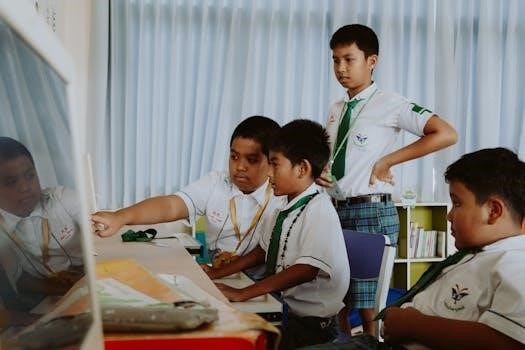Mother’s Day Lesson Plan (PDF)⁚ A Comprehensive Guide
This comprehensive guide provides educators with a structured lesson plan to celebrate Mother’s Day. It leverages various resources, including downloadable PDFs with reading materials and speech templates. The plan aims to engage students in activities that promote understanding and appreciation for mothers, culminating in creative projects.
Mother’s Day, a celebration dedicated to honoring mothers and motherhood, provides a unique opportunity for educational exploration. This lesson plan delves into the significance of this special day, fostering an understanding of the diverse roles mothers play and the profound impact they have on families and communities.
The lesson begins by activating students’ prior knowledge through engaging discussions about their own mothers and the ways they demonstrate love and care. Students will explore the historical origins of Mother’s Day, tracing its evolution from early celebrations to the modern-day traditions observed worldwide.
Furthermore, the introduction examines the cultural variations in Mother’s Day celebrations, highlighting how different societies express gratitude and appreciation for mothers. The lesson emphasizes the universality of motherhood and the shared values of love, sacrifice, and nurturing that underpin this special occasion.
Through interactive activities and thought-provoking discussions, students will gain a deeper understanding of the emotional and societal importance of Mother’s Day. They will learn to recognize and appreciate the unique contributions of mothers in their own lives and in the broader world. This introduction sets the stage for a meaningful exploration of the various aspects of Mother’s Day.
Understanding the Significance of Mother’s Day
Delving into the significance of Mother’s Day goes beyond mere celebration; it involves understanding the profound impact mothers have on individuals and society. This section of the lesson plan explores the multifaceted roles mothers play, from caregivers and nurturers to teachers and role models.
Students will analyze how mothers contribute to the emotional, social, and intellectual development of their children. Discussions will revolve around the sacrifices mothers often make, the unwavering support they provide, and the unconditional love they offer. Examining the historical context reveals how the perception and role of mothers have evolved over time, reflecting societal changes and cultural values.
The lesson plan further encourages students to consider the challenges and triumphs of motherhood, acknowledging the diverse experiences of mothers from various backgrounds. It emphasizes the importance of recognizing and appreciating the unique contributions of each mother, regardless of her circumstances.
By exploring the significance of Mother’s Day, students will develop a deeper sense of gratitude and respect for their own mothers and for all mothers around the world. This understanding fosters empathy, compassion, and a greater appreciation for the invaluable role mothers play in shaping future generations. The goal is to promote a genuine understanding of the holiday’s importance;
Lesson Objectives
The primary objective of this Mother’s Day lesson plan is to foster in students a deeper understanding and appreciation for the multifaceted roles mothers play in their lives and within society. Through engaging activities and discussions, students will explore the historical context of Mother’s Day and its evolution as a cultural celebration. They will learn to articulate the significance of honoring mothers and expressing gratitude for their contributions.
Furthermore, students will develop their creative writing skills by crafting personalized messages and descriptions of their mothers, highlighting their unique qualities and characteristics. They will also engage in hands-on craft activities to create heartfelt gifts that symbolize their appreciation and affection. These activities will encourage students to think critically about the qualities they admire in their mothers and to express those sentiments in a tangible way.
The lesson plan also aims to enhance students’ reading comprehension skills through the analysis of articles and stories related to Mother’s Day. This will help them understand the diverse perspectives and experiences of mothers from different backgrounds. Additionally, students will participate in discussions to share their own experiences and insights, fostering a sense of community and mutual respect.
Finally, the lesson plan seeks to promote critical thinking and problem-solving skills through activities such as games and quizzes centered around the theme of Mother’s Day. By the end of this lesson, students will be able to articulate the importance of honoring mothers and demonstrate their appreciation through creative expression and thoughtful reflection.
Reading Comprehension Activities
This section of the Mother’s Day lesson plan focuses on enhancing students’ reading comprehension skills through engaging activities centered around the theme of motherhood and appreciation. Students will be presented with a curated selection of age-appropriate articles, stories, and poems that explore the historical significance of Mother’s Day, the diverse roles mothers play in society, and the importance of expressing gratitude.
One key activity involves a close reading of a short article about Mother’s Day, followed by a series of comprehension questions designed to assess students’ understanding of the main ideas, supporting details, and author’s purpose. These questions will encourage students to think critically about the information presented and to draw inferences based on the text.

Another activity involves reading excerpts from personal narratives written by individuals reflecting on their relationships with their mothers. Students will be asked to identify the key emotions and experiences conveyed in these narratives, and to discuss how these stories resonate with their own experiences.
To further enhance comprehension, students will participate in vocabulary-building exercises that focus on words and phrases related to motherhood, family, and appreciation. These exercises will help students expand their vocabulary and improve their ability to understand complex texts.
Finally, students will engage in group discussions to share their interpretations of the readings and to explore different perspectives on the meaning of motherhood. These discussions will foster a deeper understanding of the topic and encourage students to think critically about their own relationships with their mothers.
Creative Writing⁚ Describing Mothers
This segment of the Mother’s Day lesson plan is dedicated to fostering students’ creative writing abilities, specifically focusing on descriptive writing skills centered around the theme of mothers. The objective is to guide students in crafting vivid and heartfelt descriptions of their mothers or significant maternal figures in their lives. This activity encourages them to observe, reflect, and articulate the unique qualities that make their mothers special.
To begin, students will participate in brainstorming sessions, generating lists of adjectives, sensory details, and anecdotes that capture their mothers’ personalities, appearances, and contributions. They will explore different aspects, such as physical characteristics, character traits, hobbies, and memorable moments shared.
Next, students will learn about various descriptive writing techniques, including simile, metaphor, personification, and imagery. They will analyze examples of these techniques in literature and practice applying them in their own writing. The emphasis will be on using language that evokes emotions and creates a strong impression on the reader.

Students will then be tasked with writing a descriptive paragraph or short essay about their mothers. They will be encouraged to incorporate specific details and sensory language to bring their descriptions to life. The writing process will involve drafting, revising, and editing, with opportunities for peer feedback and teacher guidance.

Finally, students will have the option to share their writing with the class, fostering a sense of community and appreciation for the diverse experiences of motherhood. This activity not only enhances writing skills but also promotes emotional expression and strengthens the bond between students and their mothers.
Craft Activities for Mother’s Day Gifts
This section of the lesson plan focuses on engaging students in hands-on craft activities to create personalized Mother’s Day gifts. The goal is to provide students with opportunities to express their love and appreciation through creative projects that are both meaningful and memorable. The activities are designed to be age-appropriate, accessible, and adaptable to various skill levels and available resources.
The craft activities will encompass a range of options, allowing students to choose projects that resonate with their interests and abilities. Some suggested activities include creating decorated picture frames, personalized mugs, handmade jewelry, and custom-designed flower pots. Each activity will involve step-by-step instructions, visual aids, and opportunities for students to personalize their creations.
Students will be encouraged to use a variety of materials, such as paint, glitter, beads, fabric scraps, and natural elements, to add unique touches to their gifts. They will also learn about different crafting techniques, such as decoupage, collage, and simple jewelry making. The emphasis will be on creativity, self-expression, and the joy of making something special for their mothers.
In addition to the crafting process, students will be guided in writing heartfelt messages or poems to accompany their gifts. They will learn about the importance of expressing their feelings and gratitude in a sincere and meaningful way. The combination of handmade gifts and personal messages will create a lasting impression on their mothers.
The culmination of this section will be a gift-giving ceremony, where students can present their creations to their mothers or maternal figures. This event will provide an opportunity for celebration, appreciation, and the strengthening of family bonds.
Activity⁚ Creating Mother’s Day Cards
This activity centers around the creation of personalized Mother’s Day cards, offering students a platform to express their affection and gratitude through written messages and artistic designs. The aim is to guide them in crafting heartfelt cards that reflect their unique relationships with their mothers or maternal figures. The activity promotes creativity, writing skills, and emotional expression.

Students will begin by brainstorming qualities and memories associated with their mothers. They will then use these ideas to compose personalized messages expressing their love, appreciation, and admiration. The activity will incorporate guidance on writing heartfelt sentiments and using descriptive language to convey emotions effectively. Examples of touching messages will be provided to inspire students.
The card creation process will involve a variety of art materials, such as construction paper, markers, crayons, glitter, and stickers. Students will be encouraged to use their creativity to design visually appealing cards that reflect their mothers’ personalities and interests. They will explore different card shapes, sizes, and layouts to create unique designs.
The activity will also incorporate elements of calligraphy and hand-lettering, providing students with an opportunity to enhance the visual appeal of their messages. They will learn basic techniques for creating elegant lettering styles and adding decorative flourishes to their cards. This will encourage students to take pride in their craftsmanship and attention to detail.
The culminating point of the activity will be the presentation of the cards to their mothers. This act of giving will provide students with a chance to share their heartfelt messages and express their gratitude in a tangible way. It will foster a sense of connection and appreciation between students and their mothers.
Discussion⁚ Honoring Mothers
This discussion aims to explore the multifaceted ways in which we can honor mothers, extending beyond the traditional celebration of Mother’s Day. The objective is to foster a deeper understanding of the continuous appreciation and respect that mothers deserve, encouraging students to reflect on their own actions and attitudes.
The discussion will begin by prompting students to share their personal definitions of “honoring” someone, particularly in the context of motherhood. They will explore the various ways in which mothers contribute to their lives and the sacrifices they make, fostering a sense of gratitude and recognition.
Students will delve into practical examples of honoring mothers through everyday actions. This includes acts of kindness, helpfulness, and consideration, such as assisting with household chores, offering emotional support, and actively listening to their mothers’ thoughts and feelings.
The discussion will also address the importance of verbal appreciation and expressing gratitude directly to mothers. Students will explore different ways to communicate their love and admiration, such as writing thank-you notes, offering compliments, and simply saying “I love you.”
Furthermore, the discussion will touch upon the significance of respecting mothers’ opinions and decisions, even when disagreements arise. Students will learn about the importance of open communication, empathy, and compromise in maintaining healthy relationships with their mothers.
Finally, the discussion will extend beyond immediate family, encouraging students to consider how they can honor maternal figures in their communities, such as grandmothers, aunts, and teachers. This promotes a broader understanding of the role of mothers in society and the importance of recognizing their contributions.
Game⁚ Biblical Mothers
This engaging game aims to reinforce students’ understanding of significant mothers in the Bible, connecting the Mother’s Day celebration to religious teachings and historical figures. The game will test their knowledge while fostering a fun and interactive learning environment, promoting both individual recall and collaborative teamwork.
The game will consist of a series of questions focusing on the lives, roles, and contributions of prominent biblical mothers, such as Sarah, Rebekah, Hannah, and Mary. The questions will cover various aspects of their stories, including their faith, perseverance, and impact on their families and communities.
The game can be played in various formats, such as a quiz, a matching game, or a trivia contest. Students can participate individually or in teams, fostering a spirit of friendly competition and encouraging collaboration. The format will be adapted to suit the age and learning styles of the students.
To enhance the learning experience, visual aids such as pictures or illustrations of biblical mothers can be incorporated into the game. This will help students visualize the figures and connect them to their stories, making the game more engaging and memorable.
The game will also include questions that encourage critical thinking and reflection. Students will be asked to consider the challenges faced by biblical mothers and the lessons that can be learned from their experiences. This will promote a deeper understanding of the themes of faith, hope, and love that are central to the stories of these women.
By participating in this game, students will not only learn about biblical mothers but also gain a greater appreciation for the role of mothers in general, both in religious contexts and in their own lives. The game will serve as a fun and meaningful way to celebrate Mother’s Day while reinforcing important religious teachings.

No Responses